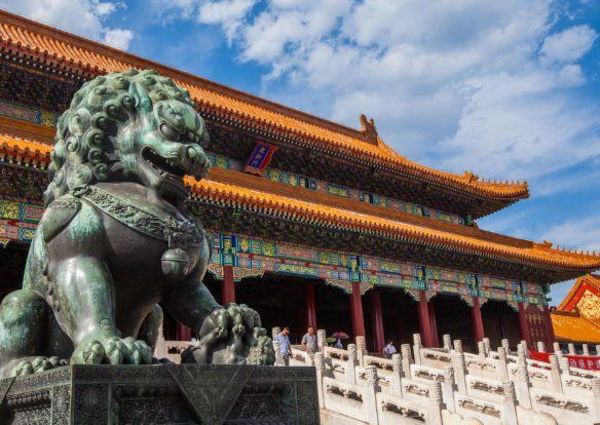
A vivid footnote on the characteristics of Chinese civilization
A vivid footnote on the characteristics of Chinese civilization
——Highlight scan of the top ten new archaeological discoveries in the country in 2023
Guangming Daily reporter Li Yun Wang Xiaofei
On March 22, the top ten new archaeological discoveries in the country in 2023, sponsored by China Cultural Relics Newspaper and the Chinese Archaeological Society, were announced in Beijing. The ten selected projects illustrate the outstanding continuity, innovation, unity, inclusiveness and peace of Chinese civilization from different angles.
Bashan Site Group in Yishui, Shandong
Constructing the cultural sequence of Shandong over 100,000 years
The Bashan Site Group is a general name for more than 80 Paleolithic remains centered on the Bashan Site in Yishui County, Shandong Province. Its discovery and research have basically established the cultural sequence of 100,000 years in central and southern Shandong and even Shandong.
According to Li Gang, a research librarian at the Shandong Provincial Institute of Cultural Relics and Archeology, more than 50,000 specimens have been unearthed and collected from the Bashan ruins, recreating the delicate historical scenes of ancient people’s production and life, as well as their survival wisdom of constantly adjusting and adapting strategies in response to environmental changes. . During the historical period when temperatures dropped, relics of ancient people’s use of fire were discovered intensively; eight ancient rhombopod jaws were found in an area of about 30 square meters, recreating the scene of ancient humans’ intensive use of giant animal resources 100,000 years ago. .
Chen Xingcan, Chairman of the Chinese Archaeological Society and Director of the Institute of Archeology of the Chinese Academy of Social Sciences, believes: “The continuous cultural accumulation and uninterrupted sequence of Paleolithic cultural development in the Bashan Site Group clearly demonstrate the continuity of early human and cultural development in this region and even in China and East Asia. The path of evolutionary development.”
Keqiutou Site Group in Pingtan, Fujian
Provide clues to the origin and spread of Austronesian languages
The Keqiutou site group includes Keqiutou, Xiying, Donghuaqiu, Guishan and other sites in Pingtan Island, Fujian, dating from 7,500 to 3,000 years ago. The coastal areas of Fujian are considered to be an important starting point for the formation of early Austronesian language groups and their spread to Taiwan, my country.
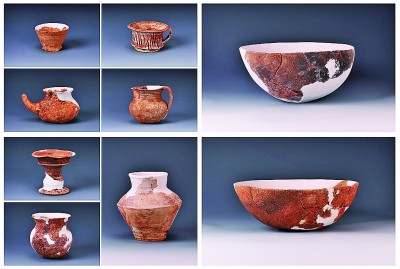
Pottery unearthed from the Keqiutou Site Group in Pingtan, Fujian Province. File photo
Zhou Zhenyu, a researcher at the Institute of Archeology of the Chinese Academy of Social Sciences, said that this group of sites shows the basic necessities, food, housing and transportation of the early Austronesian people: their livelihood model was both continental and maritime, and rich marine and terrestrial animals were found in the remains of each period. Resources; Phytolith rice remains more than 7,000 years ago were also discovered at the Xiying and Keqiutou sites, which are the earliest rice remains on the southeastern coastal islands of China. Their livelihood model of both sea and land has lasted through various periods since 7000 years.
Preliminary research on molecular biology shows that the Pingtan prehistoric people have a close genetic relationship with groups in southern China and Southeast Asia, which also indicates the continental origin of the early Austronesian people. Botanical archaeological research has found that rice and millet were introduced to Taiwan between 4800 and 4600 years ago. Chen Xingcan pointed out that the archaeological discoveries at the Keqiutou site group have deepened the understanding of the use of marine resources by prehistoric people in the southeastern coastal areas of my country and the spread of prehistoric agricultural culture to Southeast Asian island areas, and provided important clues for exploring the origin and spread of the Austronesian language group.
Mopanshan Site in Langxi, Anhui
Typical examples of research on cultural evolution in the lower reaches of the Yangtze River
The Mopanshan site is located in Xinfa Village, Feili Town, Langxi County, Anhui Province, on the east bank of Nanyi Lake, the largest lake in southern Anhui. The site can be connected to the Yangtze River water system and the Taihu Lake water system, and is an important station connecting the north, south and east and west. This site has a long duration and a complete genealogy. It is a rare central settlement in the lower reaches of the Yangtze River that has lasted for nearly 4,000 years. It has become a typical example for the study of cultural evolution in the lower reaches of the Yangtze River.
Zhao Dongsheng, associate professor at the School of History at Nanjing University, said that the Majiabang Culture, Songze Culture, Liangzhu Culture, Qianshanyang Culture, and continuous cultural accumulations from the Xia, Shang, Western Zhou to Spring and Autumn Periods were discovered at the site. The site is located in the middle of several major cultural areas, and the remains from the late Majiabang Culture to the early Liangzhu Culture are the most abundant. Zhao Hui, a professor at the School of Archeology and Museology at Peking University, believes: “The excavation and research of the Mopanshan site can also become an important reference for exploring the formation of the Songze Cultural Circle and Liangzhu Culture.”
Qujialing Site in Jingmen, Hubei Province
The wisdom of water management in the Jianghan Plain more than 5,000 years ago
The Qujialing site is located in the Qujialing Management Area of Jingmen City, Hubei Province. With Qujialing as the core, it is a large-scale Neolithic site that includes more than ten sites including Yinjialing, Zhongjialing, Zhongziba and Yangwan.

Profile model of the north wall of the Xiongjialing Dam excavation area at the Qujialing site in Jingmen, Hubei Province. Data pictures
In recent years, archaeologists have discovered multiple sets of large-scale prehistoric water conservancy systems built according to the situation here. Tao Yang, associate research librarian of the Hubei Provincial Institute of Cultural Relics and Archeology, said that many details in the construction of the dam reflect the wisdom of the ancients. For example, the ancients used the naturally distributed bedrock surface with a trend of higher in the south and lower in the north as a spillway, showing The scientific concept of “adapting measures to local conditions”. It can be seen from the Xiongjialing Dam that the ancestors expanded the dam after burning wasteland. It should have occurred during the dry season of autumn and winter, which is in line with the behavioral logic of “building water conservancy projects during the slack farming season.”
”The Qujialing site was built according to the situation. Its large-scale prehistoric water conservancy system is one of the earliest and clear water conservancy facilities discovered so far. It marks that the prehistoric ancestors’ water management concept changed from passive waterproofing and water control to active Land control and water use have achieved a leap from adapting to nature to transforming nature.” Zhao Hui said.
Wangzhuang Ruins in Yongcheng, Henan
Unique burial customs reflect the complexity of prehistoric society
The Wangzhuang site is located in Caolou Village, Miaoqiao Town, about 10 kilometers east of Yongcheng City, Shangqiu City, Henan Province. It is located in the eastern Henan Plain with flat terrain and is adjacent to the old Suishui Road in the north.
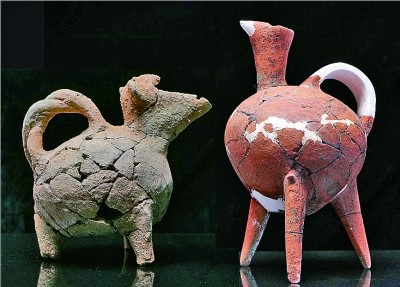
Pottery vase unearthed from the Dawenkou tomb at the Wangzhuang site in Yongcheng, Henan Province. File photo
The Dawenkou cultural relics at the Wangzhuang site have rich ritual connotations and reflect significant social differentiation. Zhu Guanghua, associate professor at the School of History at Capital Normal University, said that the “jade-covered face” unearthed from the site is the first example of this kind of remains discovered in the Neolithic Age in China, and it has a significant ceremonial nature; many tombs at the site have unearthed stone guis, and the number is consistent with the tombs. is directly proportional to the size of the tomb, and the richness of the tomb’s grave goods is highly related to the size of the tomb. “This is an intuitive reflection of the social complexity process in the prehistoric period in the region.” Zhao Hui pointed out.
The burial customs of the Dawenkou Culture tombs at the Wangzhuang site are also quite unique. There are “intentional breaks” among multiple groups of tombs. Each group of tombs has “a highly overlapping area of the tomb chambers, a similar trunk axis of the tomb owner, and a close distance between the upper and lower tombs.” And the burial pottery is continuously stacked” and other characteristics. Zhu Guanghua speculated: “The tomb owners in the same group of tombs may have a certain degree of kinship.”
Sijiaoping Ruins in Li County, Gansu Province
Suspected to be a place of worship for the First Emperor’s Western Tour
The Sijiaoping site in Li County, Longnan City, Gansu Province is a large-scale ritual building site from the Qin Dynasty. It is speculated that it may be a sacrificial site for Qin Shihuang’s western tour.
The Sijiaoping site was created by artificially flattening the original top of Sigezi Mountain to form a summit platform with an area of about 28,000 square meters. Then a ring of walls was rammed around the platform, and a high platform and corridors were built on the platform. Hou Hongwei, associate research librarian at the Gansu Provincial Institute of Cultural Relics and Archeology, said that the site as a whole is centrally symmetrical, and each group of buildings is axially symmetrical. Preliminary judgment is that this building may be a sacrificial place prepared for the First Emperor’s western tour.
The architecture of the site is clearly hierarchical and orderly. Huo Wei, academic dean of the School of History and Culture of Sichuan University, said, “This is the first time that a large-scale and well-organized large-scale building complex has been discovered locally. It is a manifestation of the country’s will and has a strong ceremonial character. , embodying the style and spirit of the early days of the unified nation in ancient China.”
The Sijiaoping ruins are another form of Qin sacrificial architecture in addition to the ancestral temple buildings and Jie sacrificial buildings. This architectural pattern profoundly influenced the architectural style of Deyang Temple, Wangmang Jiu Temple in the Han Dynasty, and even the later architectural styles of the Temple of Heaven and the Temple of Earth.
Chencun Porcelain Kiln Site in Huozhou, Shanxi
The final peak of fine white porcelain production in the northern region
The Huozhou kiln site is located in Chencun, Bailong Town, Huozhou, Linfen City, Shanxi Province.

A Ming Dynasty goblet with brown flowers on a white ground unearthed from the Chencun porcelain kiln site in Huozhou, Shanxi Province. File photo
The archaeological team revealed various important porcelain-making relics such as kilns and workshops in the late Song, Jin, Yuan and Ming dynasties, and unearthed a large number of product fragments and kiln furniture. For the first time, the appearance of products in each historical period was clarified archaeologically. and technical characteristics, establishing a historical periodization scale for Huozhou Kiln.
Liu Yan, deputy director of the Shanxi Provincial Institute of Archeology, said: “Huozhou Kiln began firing in the late Northern Song Dynasty and reached maturity in the Jin Dynasty, with fine white porcelain products becoming the mainstream product.” Huozhou Kiln in the Yuan Dynasty was the only kiln in the country that produced fine white porcelain. market, its products and aesthetics led social fashion and became the final peak of fine white porcelain production in ancient northern China. In the Ming Dynasty, Huozhou Kiln mainly produced decorative white porcelain for daily use, and was also an important porcelain industry center in the north. Huozhou kiln was used until the Qing Dynasty.
”The discovery of the Huozhou kiln site confirms that China’s fine white porcelain production center was finally formed in the northern region.” Huo Wei said that it not only made an important contribution to the development history of Chinese ceramics, but also was a living substance of the great process of Chinese cultural diversity and integration. carrier and vivid interpretation.
Cemetery in Shuyuan Street, Shangdu, Zhengzhou, Henan
Filling the gaps in the golden culture of the Shang Dynasty
The Shuyuan Street Cemetery is located in the southeast of the inner city of Zhengzhou’s commercial capital. It consists of ditches, passages, tombs, sacrificial remains, etc. It is a high-level noble cemetery in the early Sino-Shang Dynasty.
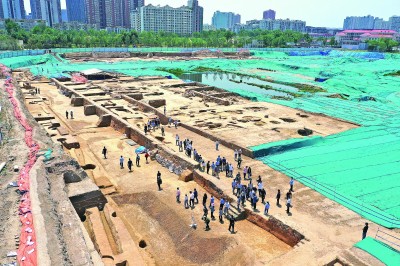
Excavation site of the cemetery on Shuyuan Street, Shangdu, Zhengzhou, Henan Province (photo taken on May 13, 2023) Published by Xinhua News Agency
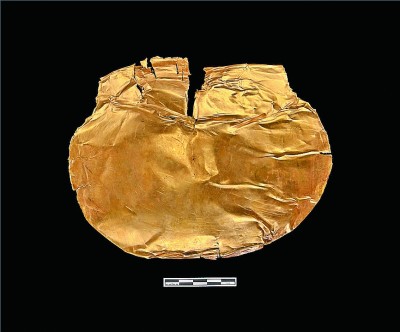
“Gold-covered face” unearthed from tomb M2 in Shuyuan Street Cemetery, Shangdu, Zhengzhou, Henan Province. File photo
In the Shuyuan Street Cemetery, the earliest standardized mega-region in China was discovered, with nearly complete mega-ditches, complex passages, high-level tombs, and various types of sacrificial remains. “This is the predecessor of the square Huanghao Zhaoyu in the northwest hillock of the Yin Ruins. It advances the history of China’s Zhaoyu to the early Sino-Shang Dynasty.” said Wang Wei, a member of the Chinese Academy of Social Sciences and director of the Department of History.
When did gold culture become popular in China? The gold artifacts unearthed from the Xuyuan Street Cemetery may provide clues to answer this question. Huang Fucheng, a research librarian at the Zhengzhou Institute of Cultural Relics and Archeology, said that in the past, most of the pre-Shang gold products discovered in archaeological discoveries were small jewelry, such as earrings. The discovery of large-scale, localized gold products, gold and turquoise plaques, and the coexistence of gold and jade ritual vessels unearthed from the Shuyuan Street Cemetery is an important symbol of the formation of China’s gold culture and filled the gap in the gold culture of the Shang Dynasty.
Rare scallop-shaped “gold-clad” and “copper-clad” were unearthed here, which were unique funeral utensils of the aristocratic class of the Shang Dynasty and were used to cover the face of the tomb owner. “Both scallops and gold are foreign items, and their combination with local funeral customs reflects the cultural innovation of the deep integration of gold and local culture. It is of great significance for a deeper understanding of the relationship between China and Eurasia’s gold dissemination and exchanges in the early Sino-Shang Dynasty.” Huang Fucheng said.
The gold masks unearthed in Sanxingdui have attracted national attention. The Shuyuan Street Cemetery is roughly more than 100 years older than Sanxingdui. “In the Shang Dynasty, there was a custom of covering one’s face with gold, which provides important information about the origin of the gold masks in Sanxingdui,” Wang Wei said.
Shaanxi Qingjian Zhaigou Site
The Northern Shaanxi Kingdom coexisted with the merchant civilization of the Central Plains
The Zhaigou site is located in Zhaigou Village, Xiejiagou Town, Qingjian County, Yulin City, Shaanxi Province. It covers an area of about 3 million square meters. Various signs indicate that this is a settlement site of the Fang Kingdom in the Shang Dynasty.

Copper octagonal carriage scale decoration unearthed from the Liujiata Cemetery behind the Zhaigou site in Qingjian, Shaanxi Province. File photo
Sun Zhanwei, associate researcher at the Shaanxi Provincial Institute of Archeology, said that the largest, largest and highest-level A-shaped noble tomb outside the Yin and Shang cultural circles was discovered here for the first time. “The scale of the tomb is very huge. Its earth volume is comparable to that of the Yin Xu royal tombs, or even higher than many Yin Xu royal tombs,” Wang Wei said.
Were the bronzes unearthed from various Fang Kingdoms cast locally or were they awarded by the Shang Dynasty? Wang Wei pointed out that a batch of pottery models with intricate and exquisite decorations and outstanding Yinxu style found at the Zhaigou site showed that the local area already had developed casting technology, and found a clear explanation for the group of bronzes that have been unearthed in the loess hilly area for decades. archaeological background.
The Zhaigou site also provides key evidence to answer the question of the origin of ancient Chinese horse-drawn carriages. The earliest physical double-coiled cart in China was unearthed here, which may be the “big cart” or “ox cart” recorded in the literature, pushing back the emergence of double-column carts in my country by about 1,000 years.
Shipwreck Sites No. 1 and 2 on the northwest slope of the South China Sea
It marks that my country’s deep-sea archeology has reached the world’s advanced level.
The No. 1 and No. 2 shipwreck sites on the northwest slope of the South China Sea are the first Ming Dynasty shipwreck sites discovered in my country at a depth of 1,500 meters.

Orthophoto of the No. 2 shipwreck on the northwest slope of the South China Sea. Data photo
According to Song Jianzhong, a research librarian at the Archaeological Research Center of the State Administration of Cultural Heritage, the shipwreck No. 1 on the northwest slope of the South China Sea was roughly dated to the Zhengde period of the Ming Dynasty. The ship’s cargo was mainly porcelain from Jingdezhen Kiln. It is speculated that it departed from Fujian or Guangdong to trade transfer stations such as Malacca. Private merchant ship; The South China Sea Northwest Slope No. 2 shipwreck dates back to the Hongzhi period of the Ming Dynasty. It is speculated that it was a private merchant ship that loaded ebony and other goods from Malacca and other trading transfer stations and returned to China. The two ships going back and forth on the same route restore to people the grand scene of the Ming Dynasty Maritime Silk Road with thousands of sails competing and sailing to thousands of countries. It helps to deeply explore and fully understand the two-way flow of the ancient Maritime Silk Road.
Song Jianzhong introduced that a variety of new technologies and equipment such as long baselines, inertial navigation and positioning systems, flexible manipulators, and submersible sand pumping and sand blowing devices were used in the investigation. In particular, the use of long baselines is the first in China. After the long baselines are laid out, the mapping and measurement of the ruins can be accurate to the meter level. Huo Wei said that the archaeological work at the No. 1 and No. 2 shipwreck sites on the northwest slope of the South China Sea fully demonstrated the cross-border integration of my country’s deep-sea technology and underwater archeology, marking that my country’s deep-sea archeology has reached the world’s advanced level and is an important step in the development of China’s underwater archeology. milestone.
”Guangming Daily” (Page 04, March 23, 2024)
